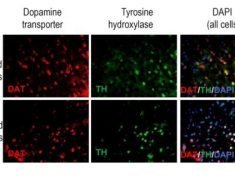Heavy ions could radically improve radiation therapy for treatment of pancreatic cancer and other difficult-to-treat tumors if researchers can better understand how the ions work against cancer.
A new instrument at Columbia University will help scientists uncover the full potential of heavy ion radiation therapy. The linac (linear accelerator) booster, supported by grants from New York's Empire State Development and the National Cancer Institute, establishes Columbia as the first institution in the United States with an instrument dedicated to research on heavy ion radiation therapy.
Carbon and other heavy ions may offer important advantages over conventional radiation therapy in treating pancreatic and other types of cancer, but the biology underlying its efficacy is not well understood. Thanks to generous grants from the state and National Cancer Institute, scientists at Columbia and other cancer research institutions will help us answer some longstanding questions about the mechanisms underlying the antitumor effects of heavy ions in an effort to develop more effective therapies for hard-to-treat cancers."
David Brenner, PhD, Higgins Professor of Radiation Biophysics and Director of the Center for Radiological Research at Columbia University's Vagelos College of Physicians and Surgeons
Interest in heavy ion radiotherapy is growing
Conventional radiation therapy mainly uses photons-; weightless particles of light-;to damage the DNA in tumor cells. The photons are generated in a linac, which then directs a beam of photons toward the cancer. But because photons are so light, they release energy in healthy tissue en route to their target. And the deeper a tumor it is, the less radiation it may receive.
An alternative type of radiotherapy that uses heavy ions-; electrically charged particles such as carbon, helium, or lithium-; may have superior tumor-killing effects and less impact on nearby tissues.
"Because these ions are more massive, they deposit energy in a more concentrated way than photons and may be able to kill tumor cells more effectively than photons, while producing fewer effects on nearby healthy cells," says Guy Garty, PhD, associate professor of radiation oncology and director of the Radiological Research Accelerator Facility (RARAF) at Columbia University Vagelos College of Physicians and Surgeons.
There are currently 13 centers outside of the United States treating patients with carbon ion radiation therapy. Safety and efficacy data from these centers show that radiotherapy with carbon ions for some hard-to-treat tumors is promising.
Carbon and other heavy ions also may trigger some sort of immune response and may help attack cancer cells that have spread to other parts of the body.
"Until now, we have only been able to study the effects of heavy ions in single layers of cancer cells," Garty adds, "but to understand all of the biological effects and optimize the treatment, we need to study heavy ions in three-dimensional tumor models or living tissue."
Booster lets ions 'surf' to pick up speed
To conduct such studies, a more powerful linac is needed to propel carbon and other heavy ions deeper into tissue.
The linac booster-;a two-meter-long series of copper tubes fitted onto the end of the RARAF accelerator-; takes advantage of the electrical charge of the ions to help them pick up speed. As the ions fly through the booster, they travel through sections that alternate between those with a positive electrical charge and no charge.
"The fields look like waves, and the ions keep riding on the positive edge of the waves like a surfer," Garty says. "Each time they pass through an electrical field, they get a kick that allows them to travel faster and faster. The booster basically doubles the energy of the particles coming out of the linac and triples their range in tissue."
Studies will focus on hard-to-treat tumors
While some carbon ion facilities are planned for the United States, it's possible that lighter ions may be capable of producing the same biological effects.
"One of our goals is to see if the effects we see with carbon ions can be reproduced with lighter ions, such as helium or lithium," Brenner says. "Carbon ion accelerators are prohibitively expensive and require a huge amount of space, but if you had a lighter ion that could do the same job, then the price and size of the accelerator would be an order of magnitude less and it would easily fit into a radiation oncology department."
Currently, researchers at Columbia are planning to study the effects of heavy ions in preclinical models of pancreatic, breast, esophageal, melanoma, and prostate tumors.
Columbia University Irving Medical Center
Posted in: Medical Procedure News | Medical Science News | Medical Condition News
Tags: Cancer, Copper, DNA, Education, Efficacy, Immune Response, Ion, Lithium, Medical Research, Medicine, Melanoma, Nursing, Oncology, Pancreatic Cancer, Preclinical, Prostate, Public Health, Radiation Therapy, Radiotherapy, Research, Tumor
Source: Read Full Article





